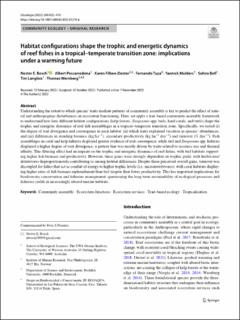| dc.description.abstract | Understanding the extent to which species’ traits mediate patterns of community assembly is key to predict the effect of natural and anthropogenic disturbances on ecosystem functioning. Here, we apply a trait-based community assembly framework to understand how four different habitat configurations (kelp forests, Sargassum spp. beds, hard corals, and turfs) shape the trophic and energetic dynamics of reef fish assemblages in a tropical–temperate transition zone. Specifically, we tested (i) the degree of trait divergence and convergence in each habitat, (ii) which traits explained variation in species’ abundances, and (iii) differences in standing biomass (kg ha−1), secondary productivity (kg ha−1 day−1) and turnover (% day−1). Fish assemblages in coral and kelp habitats displayed greater evidence of trait convergence, while turf and Sargassum spp. habitats displayed a higher degree of trait divergence, a pattern that was mostly driven by traits related to resource use and thermal affinity. This filtering effect had an imprint on the trophic and energetic dynamics of reef fishes, with turf habitats supporting higher fish biomass and productivity. However, these gains were strongly dependent on trophic guild, with herbivores/detritivores disproportionately contributing to among-habitat differences. Despite these perceived overall gains, turnover was decoupled for fishes that act as conduit of energy to higher trophic levels (i.e. microinvertivores), with coral habitats displaying higher rates of fish biomass replenishment than turf despite their lower productivity. This has important implications for biodiversity conservation and fisheries management, questioning the long-term sustainability of ecological processes and fisheries yields in increasingly altered marine habitats. | en_US |
